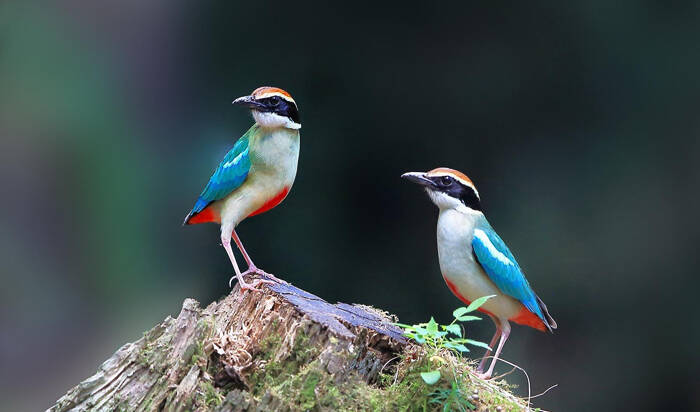Pitta nympha
IUCN
LCBasic Information
Scientific classification
- name:Pitta nympha
- Scientific Name:Pitta nympha,Fairy Pitta
- Outline:Songbird
- Family:Passeriformes Pittidae Pitt
Vital signs
- length:17-21cm
- Weight:48-70g
- lifetime:No verification information
Feature
Known as the "Fairy among Birds"
Distribution and Habitat
Distributed in Brunei Darussalam, Mainland China, Hong Kong, Taiwan, Japan, the Democratic People's Republic of Korea, South Korea, Malaysia and Vietnam. Breeds in Japan, Korea, eastern and southeastern China; winters in Borneo.
Main distribution provinces in China: Hebei, Liaoning, Shanghai, Jiangsu, Zhejiang, Anhui, Fujian, Jiangxi, Shandong, Henan, Guangdong, Guangxi, Hainan (Haikou Wuyuanhe National Wetland Park), Guizhou, Yunnan, Taiwan, Hong Kong. Summer migratory bird in Dabie Mountain, Henan, Dabie Mountain and Huangfu Mountain, Anhui, Guangdong, Fujian, Yaoshan, Guangxi, western and southern Yunnan and Taiwan. Occasionally seen in Xiahe, southern Gansu, Tianjin, Hebei and coastal Shandong during migration.
Inhabits secondary broad-leaved forests from plains to low mountains. Including plantations, subtropical or tropical moist lowland forests, subtropical or tropical dry forests, subtropical or tropical (lowland) moist sparse shrubs and rivers and streams. Also in a
Appearance
The feather colors of male and female fairy thrushes are roughly similar. The head is dark chestnut brown, with a black central crown pattern. The eyebrow pattern is yellow-white, narrow and long, extending from the base of the forehead to both sides of the back of the neck. There is a broad black line running through the eyes below the eyebrow lines, which connects from the front of the eyes, cheeks, ear feathers to the back of the neck, forming a quill shape. The surface of the back, shoulders and inner secondary flight feathers is bright dark green, and the upper coverts on the waist and tail and the small coverts on the wings are cobalt blue and shiny. The middle coverts and large coverts are green with a hint of blue; the primary coverts and flight feathers are black, the first to second primary flight feathers are all black, the tips are lighter in grayish brown, and the middle part of the remaining primary flight feathers are white. , forming conspicuous white wing spots; the ou
Details
Fairy Pitta, also known as Fairy Pitta, has two subspecies.

Fairy Pitta is a summer migratory bird and a traveling bird. It often moves alone in the grass under the bushes, foraging while walking on the ground. It is agile, alert and timid, good at jumping, and often jumps and walks on the ground. It flies straight and low, and its flying speed is relatively slow. It mainly feeds on insects, often digging in the fallen leaves with its beak to feed on earthworms, centipedes and lepidoptera larvae, and also eats insects such as coleoptera.
The breeding season of the Fairy Pitta is from May to July. It nests on trees in dense forests, mostly at the forks of tree trunks, and there are also reports of nests on rocks. The nest is made of dead branches, dead leaves, mosses, weeds, etc. into a spherical nest with holes on the side. The nest is padded with fine roots and pine leaves. Each nest lays 4-6 eggs, which are white, dotted with gray and tissue. The male and female take turns to incubate the eggs.
The Fairy Pitta is very rare, with less than 10,000 in the world! Although the Yangtze River Delta region in China should be its breeding ground, it was only recorded in Nanjing before. It has been identified as a globally vulnerable bird. There are approximately 100-1000 breeding pairs in China, and 50-1000 migratory individuals.
The Fairy Pitt has a global range of approximately 1,170,000 square kilometers. The conservation status of the species is assessed as vulnerable. It was first discovered in the Gutianshan National Nature Reserve, which is located in Suzhuang, 30 kilometers northwest of Kaihua County, 30 kilometers from the county seat, and adjacent to Wuyuan County, Jiangxi Province.
In December 2021, the Fairy Pitt was first discovered in the Anhua Liubuxi National Nature Reserve. In March 2022, researchers from the Nanshan Provincial Nature Reserve in Shixing, Shaoguan, Guangdong Province, found for the first time a clear image of the National Class II Key Protected Wildlife Fairy Pitta, known as the "Fairy among Birds", in the infrared cameras installed in the core area of the reserve.
Listed in the IUCN Red List of Threatened Species in 2016 ver 3.1-Vulnerable (VU).
Listed in the Appendix II of the Washington Convention on International Trade in Endangered Species (CITES).
Listed in the second level of China's National Key Protected Wildlife List (February 5, 2021).
Protect wild animals and stop eating game.
Maintaining ecological balance is everyone's responsibility!








